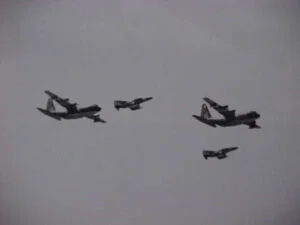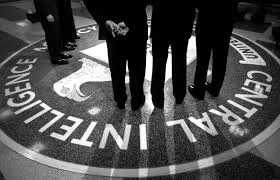Operation Popeye’s weather warfare project was conducted from Thailand over Cambodia, Laos, and Vietnam and was allegedly sponsored by Secretary of State Henry Kissinger and CIA without the authorization of then Secretary of Defense Melvin Laird who said “we have never engaged in that type of activity [weather modification] over Northern Vietnam” in Congressional testimony. [1] The top secret weather modification operations were conducted by military WC-130 planes [2][3] and RF-4 jets [4] spraying silver iodide and lead iodide into monsoon storm clouds. Operation Popeye first came to public light in March 1971, when reporter Jack Anderson [5] published The Pentagon Papers [6] and a story in the New York Times [7] based on a secret 1967 memo (below) from the Joint Chiefs of Staff to President Johnson. The memo read:
ACTIONS: “LAOS OPERATIONS – Continue as at present plus Operation POP EYE to reduce the trafficability along infiltration routes” & AUTHORITIES/POLICY CHANGE: “Authorization required to implement operational phase of weather modification process previously successfully tested and evaluated in same area”. (US Senate, Subcommittee on Oceans and International Environment; 26 July 1972; p. 5). [8]
After disclosure of Operation Popeye it was renamed to Operation Motorpool, Operation Intermediary and finally Operation Compatriot. These operations led to several congressional hearings led by Senator Claiborne Pell, [9] The Weather Modification Reporting Act of 1972, the National Weather Modification Policy Act of 1976, The Environmental Modification Convention (ENMOD) Weather Warfare Ban of 1978, and a full disclosure report titled “Weather Modification: Programs, Problems, Policy, and Potential.”
Goals:
- Softening road surfaces
- Causing landslides along roadways
- Washing out river crossings
- Maintain saturated soil conditions beyond the normal time span.
Mr DOOLIN: I speak in a personal capacity and not in my official capacity, Mr. Chairman. I have been in this job for 5 years, and I didn’t have this clearance even though Southeast Asia is in my area of responsibility in the Office of the Secretary of Defense. The first I learned of it was, as the result of a Jack Anderson column, and I made inquiries at the time – simply for my own edification… [US Senate, Subcommittee on Oceans and International Environment; 20 March 1972; p. 111] [10]

Few aviation writers and historians seem to be aware that there were three WC-130As. These three were originally trash-haulers, borrowed from TAC in late 1966 for use in Operation Popeye, the rain-making mission in Southeast Asia, set to begin the following year. The intent of the mission was to create enough year-round rain to keep the Ho Chi Minh trails impassable with mud. Tests were conducted over Laos in 1966, and the operational missions began in March of 1967 from Udorn RTAFB, Thailand. They were flown by crews of the 54th WRS, rotated on a regular basis from Guam. In addition, 54th crews were sometimes called upon to conduct synoptic weather reconnaissance from Udorn over various areas of Southeast Asia, out to and including the Bay of Bengal.
The A-models were modified for weather reconnaissance, probably at WRAMA, with the AN/AMR-1 system. They were not configured for atmospheric sampling. Two were kept at Udorn, with the third rotating to and from Guam for maintenance, repair, and crew changes, from June 1967 through late 1970. When the third one was not enroute to/from Thailand, it was used for normal weather reconnaissance activities from Guam. In late 1970 the A’s were replaced with three 1958 B-models, and the rain-making mission continued through mid-1972 with whichever B- or E-models were available from the 54th. After re-conversion to transport, the A’s were transferred to Air Force Reserve units. During their brief stint as rain-makers, they flew a total of 1435 combat sorties, and it is reported that at least one of them received battle damage. All three A-models wore the standard Southeast Asia camouflage colors and markings, but with no unit designations of any kind. In 1973, 56-0519 was given or loaned to the South Vietnamese Air Force, and it became one of the spoils of war on April 30, 1975. The last reliable sighting was in April of 1999, which reported her corroded and derelict at Tan Son Nhut Airport, Ho Chi Minh City. [2][3]
Howard Kidwell here, and I flew RF-4’s with the 14th TRS at Udorn, Thailand 1970-71.
While there, I kept hearing the call sign “Motorpool” used by two of crews in the 14th. When I inquired what they did, I got the usual reply that it was Top Secret and no one knew. I knew the crews and they wouldn’t say zip. This grows on a guy, and I had to find out what was going on. So, dummy me, I volunteered. Well, in a little while I was interviewed and told they would get a higher security clearance for me. In a few short weeks and I was told to come to Motorpool Ops for a briefing. (I found out later that friends and relatives in the states were contacted about me). The Lt Col in charge said the room had been swept for monitoring devices, etc., and I had one last chance to withdraw my volunteer statement. I had fleeting thoughts of flying over China, working for the CIA, you name it… but what the heck. I signed the statement and found out that I was going to make rain! Geez! I thought they were kidding! Not so, and soon I was flying with a Motorpool guy or Squadron GIB (Guy-in-Back) cleared for Motorpool ops.
The RF-4 could carry 52 photoflash carts or chaff carts on each side. We carried chaff to defeat Fire-Can or SAM Radars (more on chaff later). The “rain making stuff” was carried in these racks.
During the rainy season each crew flew once a day, on the average, in addition to regular missions. A “scout” plane (WC-130) would call back and “scramble” us — giving us a flight level, which was usually 19,000. We would go into the roll cloud (or whatever you WX guys call it) by the side of each thunderstorm. When it got to raining like crazy we would pickle off a cart, count to 5, pickle off another one and then you were out in the blue, made a 360 degree turn and, like magic, another thunderstorm had usually formed and you did the same thing again. It was all over Laos and we would go over the passes to do our thing.
 We were constantly getting struck by lighting of course. You could hear the rapid build up of a high pitch whine on the SAM warning gear and then “Bang!” I never got used to it. We tore up radar warning and ECM pods, you name it. Once I had a nose cone shattered, which knocked out the airspeed, so I landed using the angle of attack indicator. The Wing Commander was a friend and he would say; “Howard, I don’t know what the heck you’re doing, but whatever it is, can you please not tear up my planes?”
We were constantly getting struck by lighting of course. You could hear the rapid build up of a high pitch whine on the SAM warning gear and then “Bang!” I never got used to it. We tore up radar warning and ECM pods, you name it. Once I had a nose cone shattered, which knocked out the airspeed, so I landed using the angle of attack indicator. The Wing Commander was a friend and he would say; “Howard, I don’t know what the heck you’re doing, but whatever it is, can you please not tear up my planes?”
Motorpool carried such a high priority that if we had just one RF-4 in commission, it would fly the Motorpool mission. We would usually go to a tanker after takeoff, get some gas and go do our thing. Sometimes, if we still had carts and the “bumpers” were going, we would go back to the tanker, get 15,000 lbs. of gas and do it again. Several times we would get so fired up about our success that we found ourselves over North Vietnam with active SAM sites — and of course no chaff on board. Sometimes we would have to fly over North Vietnam to the coast, down the coast and come around south of the DMZ.
They told us that some “little green suited men” on the ground would give us “mud BDA” and it sounded like it was working.
The DFC I got for the Motorpool mission is sort of generic. Ahhh, the games people play… [4]
Related Hearings
- US Congress, Senate, Committee on Foreign Relations, Subcommittee on Oceans and International Environment, Hearing: Prohibiting Military Weather Modification, Washington, DC: US Govt. Printing Office, 26-27 July 1972, 162 pages.
- US Congress, Senate, Committee on Foreign Relations, Report: Prohibiting Environmental Modification as a Weapon of War, Report no. 93-270. Washington, DC: OS Govt. Printing Office, 27 June 1973, 7 pages.
- US Congress, Senate, Committee on Foreign Relations, Subcommittee on Oceans and International Environment, Hearing: Weather Modification, Washington, DC: US Govt Printing Office, 1974, 123 pages.
- US Congress, House, Committee on Foreign Affairs, Hearing: Weather Modification as a Weapon of War, Washington, DC: US Govt. Printing Office, 24 September 1974, 39 pages.
- US Congress, House, Committee on International Relations, Subcommittee on International Organization, Hearing: Prohibition of Weather Modification as a Weapon of War, Washington, DC: OS Govt. Printing Office, 29 July 1975, 51 pages
REFERENCES
- “The Limits of Inside Pressure: The US Congress Role in ENMOD.” The Sunshine Project (2011) See also: http://www.sunshine-project.org/enmod/US_Congr.html
- “Gallery for January 2005.” The Air Weather Reconnaissance Association (2005)
- Robinson, Charlie. “WHISKEY-CHARLIE! The History of the WC-130 Hercules.” Spectrum Web Design blog. (2000)
- Kidwell, Howard. “”Motorpool” – The rest of the story.” The Air Weather Reconnaissance Association (2005)
- “Jack Anderson.” Wikipedia
- Pentagon Papers, “Report of the Office of the Secretary of Defense Vietnam Task Force.” U.S. National Archives. (January 15, 1969)
- Hersh, Seymour. “Rainmaking Is Used As Weapon by U.S.” The New York Times. (July 3, 1972)
- Pentagon Papers, “[Part IV. C. 6. b.] Evolution of the War. U.S. Ground Strategy and Force Deployments: 1965 – 1967. Volume II: Program 5, page 50.” Report of the Office of the Secretary of Defense Vietnam Task Force
- “Claiborne Pell.” Wikipedia
- “The Need For An International Agreement Prohibiting the Use of Environmental and Geophysical Modification as Weapons of War” and “Briefing on Department of Defense Weather Modification Activity.” US Senate, Subcommittee on Oceans and International Environment; 20 March 1972; p. 111
- “Weather Modification: Hearings before the Subcommittee on Oceans and International Environment of the Committee on Foreign Relations, United States Senate.” The Vietnam Center and Sam Johnson Vietnam Archive, Texas Tech University. (2002)
- “Weather Modification in North Vietnam and Laos (Project Popeye).” Memorandum From the Deputy Under Secretary of State for Political Affairs (Kohler) to Secretary of State Rusk. Department of State, Central Files, POL 27 VIET S. Top Secret. Drafted by Hamilton.
- “Convention on the prohibition of military or any hostile use of environmental modification techniques, 10 December 1976.” International Committee of the Red Cross.
- United States. Congress. Senate. Committee on Foreign Relations. “Environmental Modification Treaty: Hearing Before the Committee On Foreign Relations, United States Senate, Ninety-fifth Congress, Second Session … October 3, 1978.” Washington: U.S. Govt. Print. Off., 1978.















